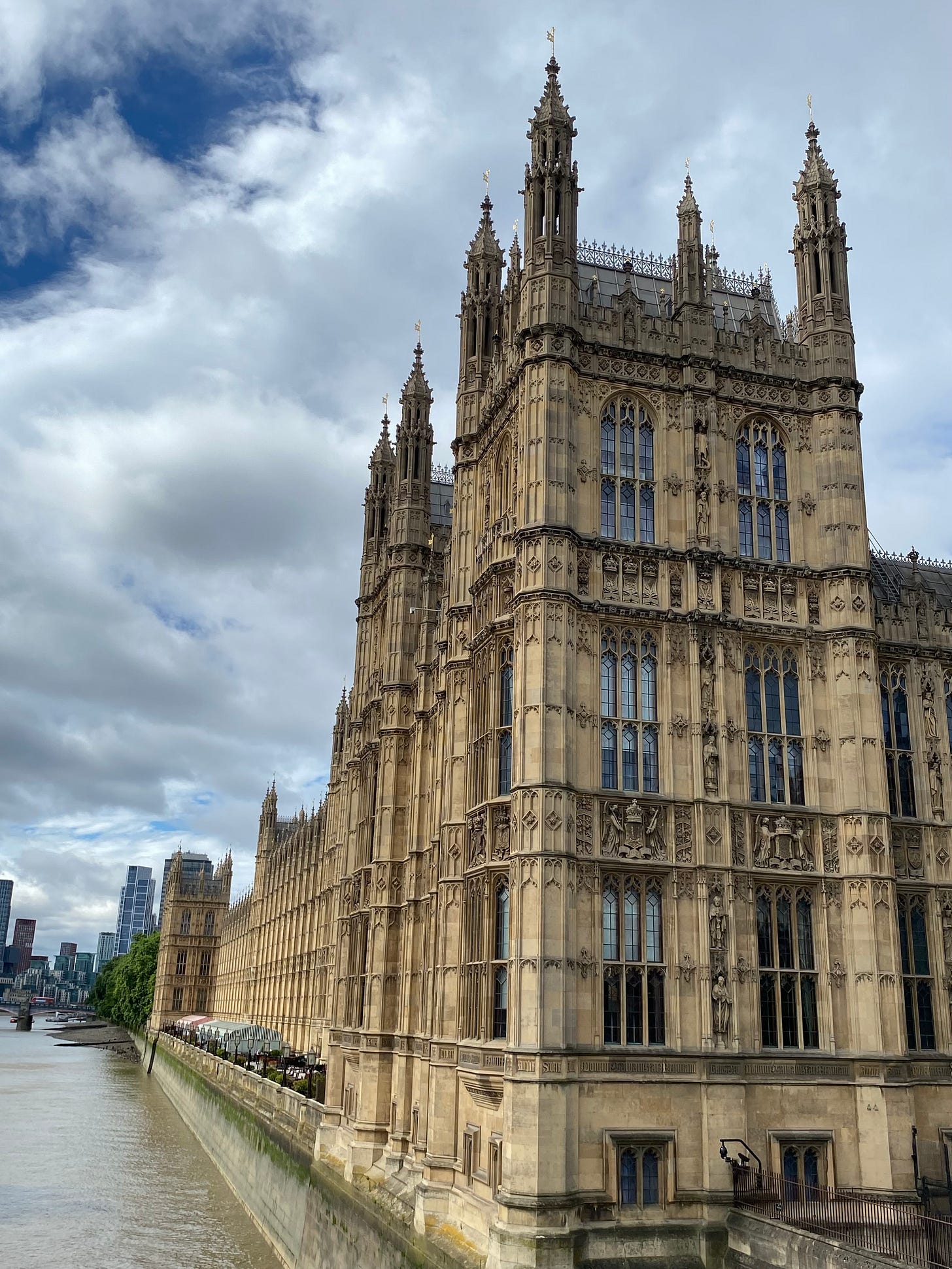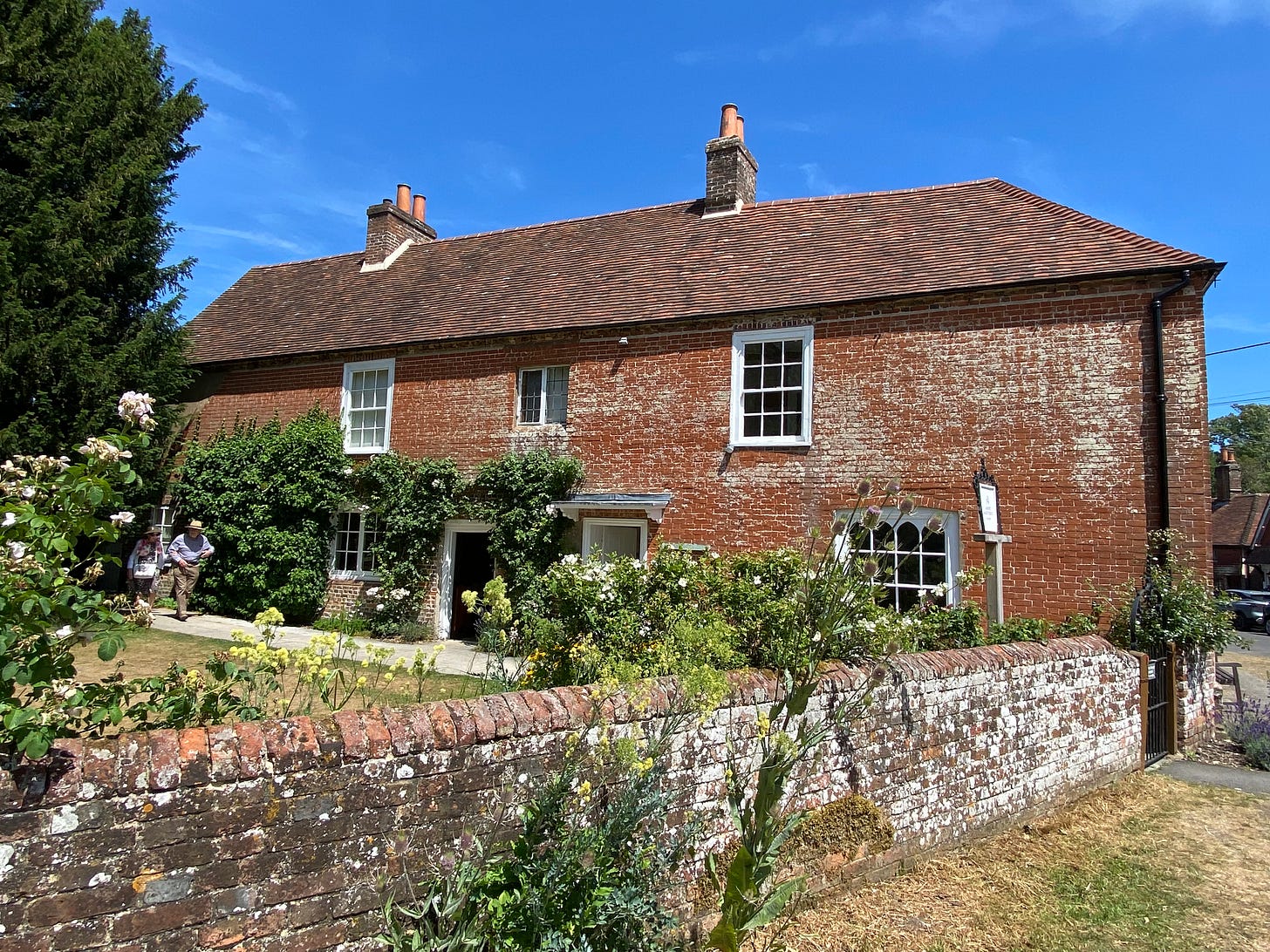Last month my husband, Matt, and I took a quick trip to London. As is my wont, I immediately began imbibing life lessons (and also beer).
To start us off, check out the photo below. Do you see the red and green tents on the terrace along the river? They are separate tea houses for, respectively, the lords and the commoners in Parliament—who, I guess, refuse to take tea together?1 You just have to laugh. Social divisions persist, and before we can come together to fix our problems, we have to acknowledge that our divisions, symbolized here by the rival tents, are pretty silly.

Other London lessons were more edifying, though. For example:
You can learn a lot from cabbies. I know we all love to dunk on Thomas Friedman for pontificating about countries based on his conversations with cab drivers, but I truly did have a fascinating and informative conversation with a London cabbie, whom I’ll call Tony.
Tony had to master the Knowledge. London cabbies must learn all 25,000 labyrinthine London streets, all the landmarks, all the routes between them, as well as locations of shops and restaurants. It is considered the most difficult test in the world. Tony needed three years of daily study to pass, which is about average. He woke early every morning and memorized four routes before going to his job. Once he mastered the hundreds of routes, he learned the landmarks, and then the through-routes and suburban streets. Studies have shown that London cabbies have significantly larger hippocampi than us regular folks.
I asked Tony whether he thought GPS and autonomous vehicles would eliminate the need to acquire the Knowledge and also take jobs from cabbies. But Tony isn’t worried. GPS doesn’t work well in London, because London isn’t on a grid. (Amazingly, passengers sometimes try to persuade Tony that they know a better route than he does. Can you imagine the audacity?) As for autonomous vehicles, Tony pointed out that they have to obey the speed limit and aren’t allowed to weave in and out of lanes to get a better position in traffic. As he put it, once customers discover that cabbies are much faster than the robot alternative, they will choose human drivers.
We aren’t masters of the universe. Not even if we were one of the most powerful and effective leaders in world history. On the floor near the west entrance to Westminster Abbey is a memorial to Winston Churchill. He is not buried there, though, because he didn’t want people walking over his grave. Fair enough. But then there’s Churchill’s statue, just outside the Abbey. An electric current runs through the statue to ward off pigeons, because Churchill didn’t want his statue to be covered in poop. You can see for yourself how well that worked out:
Traditional marriage wasn’t always that traditional. At the National Portrait Gallery, I was amused to see the portrait of Charles II surrounded by his harem. In the photo below, Charles is in the middle, and his queen, Catherine of Braganza, is on the upper right. On the upper left is Barbara Villiers, Charles’s unpopular Catholic mistress. Below her is Nell Gwynn, the self-styled “Protestant whore.”2 I’m not sure who the mistress on the lower right is, but you can see portraits of some of the main mistresses here (there are a lot of them!) if you’re curious.
More poignantly, the curators chose to hang the portrait of King James VI and I next to that of George Villiers, the first Duke of Buckingham, while the portrait of James’s wife, Queen Anne, hangs in another room. As Lucy Hughes-Hallett discusses in her excellent book, The Scapegoat, James was gay but could not live openly. He had a series of “favorites,” beautiful young men who shared his life and his bed. James’s dearest favorite was Buckingham, a commoner whom James elevated to the highest circles of power. James considered Buckingham to be his true wife, and while Buckingham was a bounder and a horndog (and also heterosexual), Hughes-Hallett believes that he loved James too. So it is fitting that the couple is now united, if only through their portraits.
“I don’t oppose all wars. . . . What I am opposed to is a dumb war.” For centuries, people were slaughtered in religious wars in Europe. In England, the Catholic Mary Tudor earned the sobriquet Bloody Mary when she burned 280 dissenters at the stake. Queen Elizabeth I, for her part, set up a secret police to root out and persecute Catholics. But Elizabeth and Mary, mortal enemies in life, share a grave in death, in Westminster Abbey. A placard near their tomb intones, “[R]emember before God all those who divided at the Reformation by different convictions laid down their lives for Christ and conscience’ sake.” Alternately, we could argue that using God as an excuse for sacrificing our lives or, worse, killing a bunch of people is the apotheosis of taking God’s name in vain.3
Let’s turn away from war, enmity, and violence, and visit instead the peaceful, light-filled chapel next door to Elizabeth and Mary, the Chapel of King Henry VII:
Henry VII of Lancaster married Elizabeth of York. As Rick Steves puts it, “Their love and marriage finally settled the Wars of the Roses” (p. 139). Make love, not war!
Look around. It is easy to become overwhelmed by the size and majesty of Westminster Abbey, but attentive visitors are rewarded with fascinating details. For example, there is a large memorial to Shakespeare in Poet’s Corner. I was moved to see that my hero (and Shakespeare’s biographer and critic), Samuel Johnson, sits at the Bard’s right hand. By contrast, Edward Bulwer-Lytton, of “it was a dark and stormy night” fame, is, appropriately enough, buried at the opposite end of the church from Poet’s Corner.
The abbey also honors humble workers who have contributed their talents. There is a grave for the “plumber to the college at church,” and a stained-glass window is dedicated to the workers who restored the windows after they were destroyed by German bombs: “In the handiwork of their craft is their prayer. Eccl. 38:34.”
Some details are amusing to modern visitors. For example, the medieval fresco below features a “wild asse” (on the left) and a “tame asse” (on the right). Which kind of asse are you, readers? Wild or tame?
Other details are sobering. We were occasionally ambushed by graves of little children, and a placard on the floor commemorates the twenty-six monks at the Abbey who died of the Black Death in 1348. Let no one tell you otherwise. The best time in all of human history to live is right now.
No really. Split up. I have argued before that when traveling with friends or family, we can eliminate a lot of stress if we don’t insist on doing every dang thing together. It’s ok to admit that interests differ. Take Jane Austen. I badly wanted to see her house, an hour’s train ride from London, but, unsurprisingly, Matt was not tempted by this prospect. So we split up for the day.
On the pleasant trip to and from Austen’s village, I listened to podcasts and looked at the scenery. Once there, I explored the pretty little village; strolled to Chawton, where Austen’s house sits at the edge of her brother’s grand estate; quaffed a beer at the pub across the street while I waited for my timed entry; and toured Austen’s modest house and garden. This was a perfect day for me. Matt, by contrast, went to the British Library, the National Gallery, the National Portrait Gallery, the Wellcome Trust gallery, and a concert. In one day! (If it’s not clear from this exhausting list, Matt has MUCH more energy than I have. This itinerary would have left me footsore and brain dead.)
We need a competence. A competence is an old-fashioned term for “an income sufficient to furnish the necessities and modest comforts of life.” When people have at least a competence, the whole society benefits. Jane Austen’s life is a perfect illustration of this principle.4 Austen was one of eight children, and her father, a clergyman, while not rich, earned sufficient income to keep the family comfortable. Freed of financial worries, Austen wrote juvenilia as well as drafts of novels that would become Pride and Prejudice and Northanger Abbey. However, after her father’s retirement, the family’s fortunes declined, and after his death, the situation of Jane, her mother, and her sister, Cassandra, was truly dire. Austen seems to have stopped writing altogether during this period.
Luckily for millions of readers and moviegoers around the world, as well as for the companies who profit from Austen’s books and the workers whose jobs depend on her, Austen’s brother Edward had been adopted into a rich family. He purchased a lovely little cottage next to one of his estates and gave it to his mother, sisters, and their friend Martha Lloyd, so they could spend the rest of their lives in security and comfort.
Relieved of the anxiety and misery of poverty, Austen’s creativity blossomed, and in the eight years between moving to Chawton Cottage in 1809 and her death in 1817, Austen revised, wrote, and published the six novels for which she is so beloved. What could the mute inglorious Miltons of our own time and place offer the world, if only we summoned the fellow feeling to lift their burdens a bit?
How about you, readers? What are some fun facts and life lessons you have picked up on your travels? Please share your thoughts in the comments!
The Tidbit
“We sing it again as if it might turn out this time.” A highlight of our trip was a matinée performance of Hadestown, the award-winning musical about an Appalachian Orpheus and Eurydice. Of course the ending is devastating.5 And yet, as the finale reminds us, we keep singing our sad songs in the hope that one day we can bring about a better world.
Rick Steves, London (Berkeley: Hachette, 2017), p. 119.
This moniker comes from a famous anecdote: Nell’s carriage was surrounded by an angry mob, so she poked her head out the window and called out, “Pray good people be silent. I am the Protestant whore!” Which did the trick! Chagrined, the crowd dispersed.
Opposition to wars over minor doctrinal differences isn’t confined to our own secular era. Jonathan Swift, an Anglican cleric as well as an author, satirized war between Protestants and Catholics in Gulliver’s Travels (1726). While visiting Lilliput, Gulliver is shocked to discover that thousands of Lilliputians have died in a war between “Big-Endians”—people who open their hard-boiled eggs at the big end—and “Little-Endians”—people who open their hard-boiled eggs at the little end.
The information in this section comes out of my own head but is confirmed by Sophie Reynolds, A Jane Austen’s House Souvenir Guidebook (London: Pitkin Publishing, 2022).
But here’s a nice story: Our daughter, Casey, told me that after the final performance of the actor who first played Orpheus on Broadway, the cast performed an alternate ending, in which Orpheus and Eurydice escape Hades together.









A kinda-sorta defence of my city and country: all that medieval nonsense like the House of Commons and House of Lords not getting tea together still happens today because people think it's quirky and fun. There's also a convention that says you're not supposed to accuse other politicians of lying when you're in the Commons, leading to the classic example of one Member of Parliament accusing another of "being economical with the truth".
Great read! Love love me some London! Just wrote about my complex affinity for “her” a few days ago! https://substack.com/home/post/p-167930273?source=queue